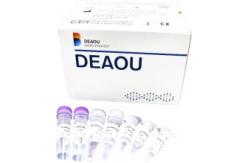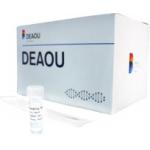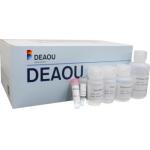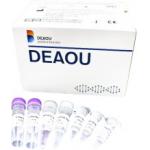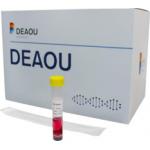Lightweight Rapid Test Kit / Diagnostic Test Kits For Nucleic Acid Detection
|
|
[ Product name]COVID-2019 Virus Nucleic Acid Detection Kit(Dual-RTPCR) [Item NO.] A001 [Product types] 50 tests / kit [Expected usage] This kit is used for nucleic acid detection of novel coronavirus (2019-ncov) in all kinds of respiratory tract samples, such as pharyngeal swab, sputum, alveolar lavage fluid, etc. The results can be used for auxiliary diagnosis of patients with novel coronavirus infection or suspected of novel coronavirus infection, providing molecular diagnostic basis for patients with infection. [Testing principle ] Two set of PCR primers and probes were designed based on the conservative sequence of Open Reading Encoding Frame gene (ORF1ab) and the core protein gene (N gene) of the novel coronavirus (2019-nCoV), and the detection kit achieved simultaneously detection of the aforementioned targets with high specificity. With PCR reaction going, fluorescence signal generated by the probe could be detected by automatic fluorescence PCR detector and realized real-time monitoring of RT-PCR. [Composition ]
Note: Positive quality control and negative quality control shall be set for each test to monitor the test body and operation environment; the negative and positive quality control products have been packed in the kitand can be used directly without extraction. [ Storage conditions and expiry date ] 1. Keep away from light and sealed at-20±5℃.Transport at 2~8 ℃ or in dry ice type environments for 7 days at most. It has a shelf life of 6 months. 2. Avoid repeated freeze-thaw cycles. Five freeze-thaw cycles will not affect the detection results. [ Applicable instruments ] It can be adapted to the real-time fluorescent quantitative PCR instrument with FAM and hex (VIC / Joe) channels from various manufacturers. [ Sample requirement ] 1. Applicable sample type: alveolar lavage fluid, throat swab, sputum. 2. Sample collection: collect samples in sterile containers with a sample volume of no less than 1ml.
[Steps] 1. Sample processing (sample processing room) Specimen type: upper respiratory tract specimen (URT): including pharyngeal swab, nasal swab, nasopharynx extract and pharyngeal rinse. 2 S-A001A1
Lower respiratory tract specimen (LRT): including respiratory tract extract, broncholavage fluid, lung tissue biopsy specimen. Sample processing methods are shown in the following table :
2. Extraction of viral RNA Self prepared extraction reagent, or according to the instructions of viral RNA nucleic acid extraction kit (centrifugation method) of Guangzhou DEAOU Biotechnology Co., Ltd 3. Reagent preparation (reagent preparation room) 3.1. Take out the components in the packing box and place them at room temperature. After the temperature is balanced to room temperature, mix them evenly and centrifugate them for later use. 3.2. Prepare the reaction solution according to the required number of reaction tubes. Set the required number of reaction tubes as n (n = number of samples + 1 tube positive control + 1 tube negative control). The preparation method is as follows:
After mixing the prepared reaction system, each reaction tube gets 20 μ L reaction solution and 20 μ l sealing liquid is added to each tube. Transfer to sample processing area. 4. Sample adding (sample processing room) Take 5μL of the above processed samples, positive control and negative control respectively and add them into the corresponding 0.2ml PCR reaction tube, close the tube and transfer them to the detection area. Note: in the process of sample adding, it is necessary to avoid using the pipette to blow repeatedly, so as not to cause a large number of bubbles which will affect the experimental results. In addition, it is necessary to centrifuge for a short time before using the machine for amplification, so as to remove the bubbles as much as possible. 5.PCR amplification (PCR amplification room) 5.1 Instrument setting (take ABI7500 instrument as an example) Put the PCR reaction tube into the PCR instrument, and set the negative, positive and unknown samples according to the corresponding sequence of samples. Since this kit needs double detection, it contains two probes with different fluorescent labels. FAM and Vic channels should be selected simultaneously for reporting fluorescent groups. 5.2. Amplification procedure
The fluorescence signal collection is set at 60 ℃, and the reaction system is set at 25 μ L. [Quality control standard]
6. Result analysis
The baseline is set with 3-10 or 6-15 cycles of fluorescence signals. The threshold setting principle is that the threshold line just exceeds the highest point of the negative control amplification curve, and it can also be adjusted according to noise condition. Result judgement
[product performance index] 1. Specificity The primer probe used in this kit is designed according to the conserved sequence of novel coronavirus (2019-ncov), which has a high detection rate for the target gene fragment. This kit has no cross reaction with the samples of coronavirus (NL63, HKU1, 229 e229e OC43, SARS SARS), influenza a virus, hepatitis b virus, respiratory syncytial virus, adenovirus, influenza virus, pneumonia klebsiella bacillus, streptococcus pneumoniae, haemophilus influenzae, pseudomonas aeruginosa, eosinophilic lung legionella, whooping cough bacili, staphylococcus aureus and pneumonia mycoplasma and pneumonia chlamydia . The coincidence rate of positive and negative reference materials in testing enterprises is100%. 2. precision The coefficient of variation (CV%) of CT value in the test results is less than or equal to 5%. 3. Minimum detection limit The minimum detection limit of this kit is 1000 copies / ml. 4. Linear range 2×10 ~2×10 copies/mL [ Notes ] 1. This product is only used for external diagnosis. 2. The detection of viral nucleic acid depends on the correct sample processing, transportation, preparation, etc. Unreasonable sample collection, processing, transportation and low sample concentration may lead to false negative results. 3. PCR test or test related shall be operated by qualified or familiar person . 4. Negative and positive control substance shall be set for each test. 5. Please operate the experiment strictly in different areas. The articles in each area are for special purpose. Do not cross use them to avoid pollution. Clean the workbench immediately after the experiment. 6. All test samples shall be regarded as infectious substances. During the experiment, work clothesand disposable gloves shall be worn and gloves shall be replaced frequently to avoid cross contamination between samples. Sample operation and waste disposal shall meet the requirements of relevant laws and regulations: “General guidelines for biosafety of microbiological and biomedical laboratories “and “regulations on clinical waste management” issued by the Ministry of health. 7. 10% hypochlorite or 75% alcohol, ultraviolet lamp or ozone shall be used to disinfect the operation platform, pipette, centrifuge, PCR amplification instrument and other equipments.
8. Wastes (such as gun heads) that have been exposed to standard samples and reference materials in the test,centrifuged tubes and samples that have been amplified shall be disposed innocuously before being discarded. 9. The reagent shall be fully melted and mixed at room temperature. 10. The mixture of PCR reaction should be kept away from light. 11. Try to avoid bubbles in the reaction tube. 12. Do not mix reagents of different batches. Please use the kit within the validity period.
【Warning】
1. Must keep away from light and store at-20±5 ℃. Transport at 2~8 ℃ or in dry ice type environments for 7 days at most. It has a shelf life of 6 months.
2. Avoid repeated freeze-thaw cycles. Five freeze-thaw cycles will not affect the detection results.
|
||||||||||||||||||||||||||||||||||||||||||||||||||||||||||||||||||||||||||||||||||||||||||||||||||||
| Product Tags: virus test kit diagnostic test kits | ||||||||||||||||||||||||||||||||||||||||||||||||||||||||||||||||||||||||||||||||||||||||||||||||||||

